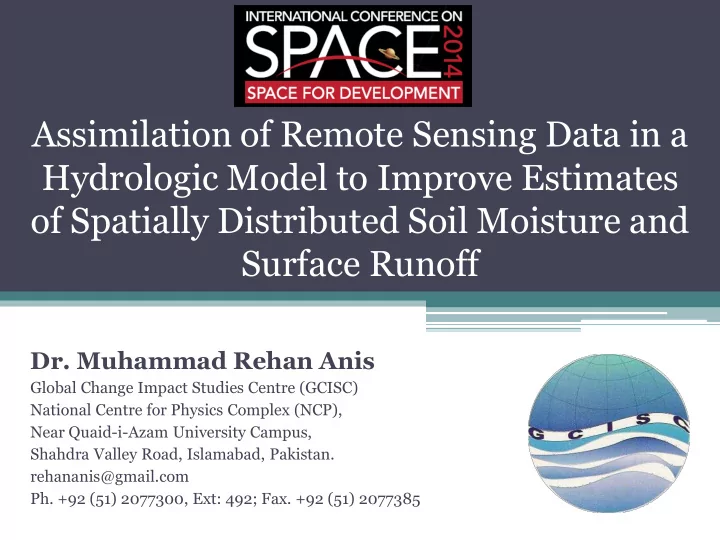

Assimilation of Remote Sensing Data in a Hydrologic Model to Improve Estimates of Spatially Distributed Soil Moisture and Surface Runoff Dr. Muhammad Rehan Anis Global Change Impact Studies Centre (GCISC) National Centre for Physics Complex (NCP), Near Quaid-i-Azam University Campus, Shahdra Valley Road, Islamabad, Pakistan. rehananis@gmail.com Ph. +92 (51) 2077300, Ext: 492; Fax. +92 (51) 2077385
http://wasim.ch/en/index.html WaSiM (Water balance Simulation Model) Multi Layer Landuse (Seasonal) Multi Horizon Soil Table Silting up model and Surface Routing-module Irrigation model Lake model Snow Model Dynamic Glacier model Static glaciers, dynamic glaciers Dynamic phenology Permafrost Model Heat Transfer Model
High resolution rainfall-runoff modeling Schäfertal catchment Located in Lower Harz Mountains Area = 1.44 km 2 Elevation = 392m - 470m Avg. Ann. Temp= 6.8 o C January= -1.8 o C July = 15.5 o C Annual Rainfall 650mm Spatial Resolution = 10 m 2 Temporal Resolution = 10 minute Land use Type Pine Forest Winter Barley Summer Barley Flax Meadow Tracks Stream Soil Type Gleysol Fluvisol Gleyic Cambisol Luvisol Cambisol
Validation 10-min WaSiM-ETH simulation IVF: 1.01 NSE: 0.86 Distribution of soil moisture in Schäfertal catchment (1 st October 2007 at 23 hrs)
Polarimetric Decompositions for Soil Moisture Retrieval from Vegetated Soils in TERENO Observatories Satellite Data Acquisition • TerraSAR-X and TanDEM-X data collection • Rapid Eye Data collection Airborne Campaigns • Airborne and the associated ground measurements campaigns • Conduction of the airborne campaigns (May/June) • Processing of the ground and airborne data • Model inversion to soil moisture (polarimetric SAR Data) Observatory Optic SAR In Situ Soil Moisture, Bode Catchment Hyperspectral F-SAR & L-band Vegetation, Roughness
Observerd soil moisture in Schäfertal …based on 100 „strategic“ sampling points… …after identification of similar areas based on topography using „fuzzy c - means“… …this similarity was finally used to project the measurements to a continuous map. In this case soil properties are mainly governed by topography.
Validation scheme for SMOS (temperature brightness-T b ) and soil moisture products.
An Overview of Data Assimilation Particle filter method is more accurate and faster than the Extended Kalman filter (EKF) or unscented Kalman filter (UKF) J. A. Vrugt et al., 2013. “Hydrologic data assimilation using particle Markov chain Monte Carlo simulation: Theory, concepts and applications”. Advances in Water Resources 51, 457 – 478. Particle-DREAM → Posterior state t+1 estimation using particle MCMC P-DREAM(VP) → State Augmentation or ? Time-variant Parameters P-DREAM(IP) → Outside DREAM Loop X Discharge or Time-invariant Parameters Excerpt at Time t SODA: Simultaneous Optimization and Data Assimilation method (EnKF) Time (hrs)
Particle - D IFFE R ENTIAL E VOLUTION A DAPTIVE M ETROPOLIS (P-DREAM) Catchment Model
Data Assimilation using P-DREAM and WaSiM Hydrological Modeling Summer Runoff IVF R 2 NSE Simulated 19/06 - 14/07/2007 0.92 0.29 0.29 Assimilated 19/06 - 14/07/2007 0.86 0.85 0.81
Estimated soil moisture generated using remote sensing technique and used in P-DREAM data assimilation algorithm to improve the peak summer runoff. (a) Peak summer discharge at 12:20hrs on 21/06/07 (b) Peak summer discharge at 18:00hrs on 25/06/07 (c) Peak summer discharge at 09:50hrs on 02/07/07.
Conclusion Data assimilation of surface soil moisture improves model predictions especially reducing errors in surface runoff and soil moisture estimation. Soil moisture update through data assimilation can be a supplementary way to overcome the errors created by inaccurate rainfall. Soil moisture estimations are useful for improved flood predictions during transition periods from wet to dry in early spring and from dry to wet in early autumn.
Thank You & Questions Soil moisture seasonality derived from the combination of six active and passive sensors over the period 1979 to 2010 Credit: Vienna University of Technology – TU Wien (TUW)
Recommend
More recommend